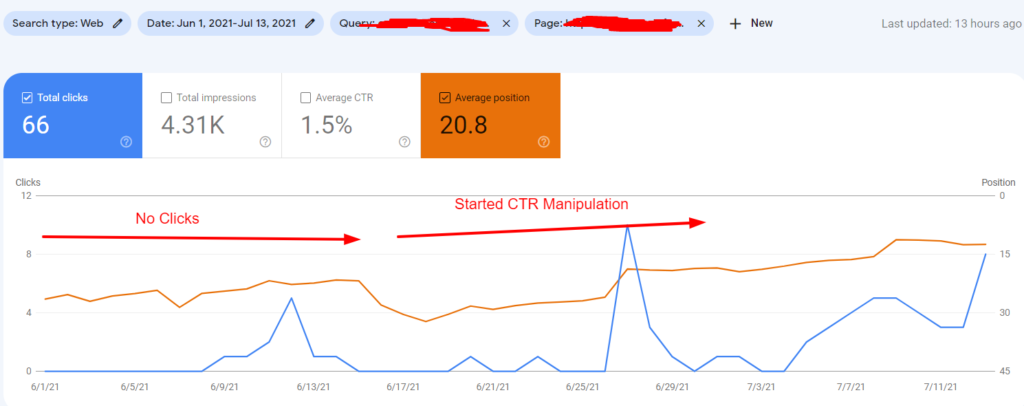CTR Manipulation-- Efficient Techniques for Increasing Click-Through Rates
CTR Manipulation-- Efficient Techniques for Increasing Click-Through Rates
Blog Article
CTR Manipulation: A Game Changer for Digital Projects
The rise of CTR adjustment has indisputably transformed electronic marketing techniques, giving marketing experts with devices to improve interaction and drive website traffic effectively. What ramifications might this balancing act hold for the future of electronic campaigns?
Understanding CTR Adjustment
Although click-through rate (CTR) manipulation might appear like a straightforward method in electronic advertising, it encompasses a variety of strategies targeted at synthetically inflating interaction metrics. This adjustment can take different forms, consisting of using click farms, robots, or deceitful advertisement positionings that misinform consumers right into clicking. These approaches can endanger the stability of efficiency information, making it challenging for marketing professionals to assess the genuine efficiency of their campaigns.
Furthermore, CTR control raises honest issues, as it weakens the transparency of digital marketing. The reliance on filled with air metrics can lead to illinformed marketing decisions, skewing resource allotment and project methods. As a result, businesses may invest heavily in channels and strategies that appear successful however do not yield genuine engagement or conversions.

Benefits of Click-Through Rate Optimization
Enhancing click-through rate (CTR) is crucial for enhancing the performance of electronic advertising and marketing projects. A higher CTR suggests that a bigger percentage of users are engaging with the web content, which can result in enhanced website traffic and much better conversion prices. By boosting CTR, brand names can effectively allocate their advertising and marketing resources to campaigns that generate the highest returns.
One of the main benefits of CTR optimization is the possibility for boosted ad positioning and reduced expenses - CTR Manipulation. Systems like Google Advertisements reward higher CTRs with far better advertisement positioning and lowered cost-per-click (CPC), permitting marketers to stretch their budgets better. In addition, a well-optimized CTR can improve brand name presence, as higher engagement prices commonly associate with raised natural reach

Strategies for Efficient CTR Adjustment
To properly adjust click-through prices (CTR), marketing experts can use a selection of critical strategies that boost customer interaction and drive traffic. One basic method is enhancing advertisement copy to create engaging and action-oriented language. CTR Manipulation. Using solid call-to-action (CTA) expressions encourages customers to take instant action, raising the probability of clicks
One more effective strategy is A/B testing, which permits marketing professionals to compare various ad variations. By methodically analyzing performance metrics, they can recognize which components reverberate best with the target market, thus refining their approaches for maximum influence. Furthermore, leveraging aesthetically attractive graphics and succinct messaging can record attention promptly, making it extra probable that users will engage.

Finally, maximizing touchdown web pages to ensure a smooth user experience can reduce bounce prices and encourage additional interaction, inevitably fostering higher CTR. By incorporating these strategies, marketing experts can successfully adjust CTR to achieve their project objectives.
Gauging Success in Digital Campaigns
Determining success in digital campaigns calls for a clear understanding of crucial efficiency indicators (KPIs) that align with project purposes. KPIs act as measurable metrics that assist analyze the effectiveness of different methods used throughout the project. Usual KPIs include click-through prices (CTR), conversion rates, cost per procurement (CERTIFIED PUBLIC ACCOUNTANT), and roi (ROI)
To efficiently gauge success, it is vital to develop details, measurable objectives first of the project. If the main objective is to raise brand awareness, metrics such as impressions and engagement prices might be focused on. In comparison, campaigns concentrated on straight sales would profit from a much more detailed evaluation of conversion rates and revenue created.
Normal analysis of these GMB CTR Manipulation KPIs makes it possible for online marketers to make data-driven choices, enhancing their techniques in real-time. Utilizing logical devices can aid in monitoring efficiency and identifying trends, enabling speedy modifications to boost campaign end results. Inevitably, a thorough approach to determining success not just highlights locations for renovation yet additionally strengthens the overall performance of digital advertising and marketing efforts, driving sustained growth and engagement in the long-term.
Future Trends in Digital Marketing
Expecting the future of electronic advertising and marketing discloses a landscape formed by rapid technical innovations and altering customer habits. As man-made knowledge and device understanding remain to develop, online marketers will progressively leverage these innovations to customize campaigns at an extraordinary scale. Anticipating analytics will enable brand names to expect consumer demands, optimizing ad positionings and content distribution in real time.
In addition, the increase of voice search and wise tools is transforming exactly how consumers communicate with electronic content. Marketing experts will need to adjust their techniques to guarantee exposure across multiple systems, including voice-activated assistants. This shift necessitates an emphasis on conversational advertising and marketing, stressing interaction with discussion instead than typical advertising tactics.
Additionally, privacy problems are triggering adjustments in data collection methods. Transparency and moral data usage will certainly end up being vital, driving brand names to foster depend on and commitment amongst consumers. The ongoing development of social media platforms will also affect marketing approaches, with an increased emphasis on authenticity and user-generated material.
Verdict
In summary, CTR manipulation represents a considerable improvement in electronic advertising and marketing techniques, supplying instant benefits with boosted interaction metrics. However, the ethical factors to consider bordering such methods demand a careful strategy to make certain long-lasting brand stability and real target market connection. By striking an equilibrium in between optimization methods and genuine engagement, online marketers can grow sustainable connections with consumers. The recurring advancement of digital advertising will certainly depend on this delicate interplay, shaping the future landscape of brand-consumer communications.
Report this page